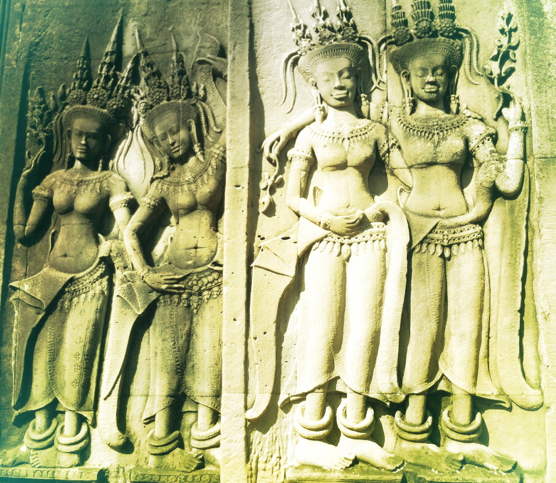Lessons in Cambodian Drag

On a tinseled stage at the back of the Siem Reap Night Market, the ladyboys emerge from glittering curtains, swivel their narrow hips, twerk in miniskirts, and squat in stilettos, revealing muscular thighs. For the opening number, the lead lip-syncs to Beyoncé, flipping her perfect, glossy ponytail with a bow down, “b*tches divatude” I’m convinced would make Queen Bey proud. Two floppy-haired, denim-clad backup boys flank her, performing choreography with zero swagger but total heart.
“Don’t just stand there on the wall/Everybody just move your body.”
Meanwhile, local Cambodians and tourists relax in bubblegum pink recliners at the open-air massage parlor that assumes the dance floor. The deal is three dollars for a 30-minute foot massage and a “Free Daily Ladyboy Show,” during which they talk, text, clap along, or pay no attention at all.
Of all the responses one could have to this scene, I think of that ubiquitous quote, the one that you see on magnets, bookmarks and email forwards, and is attributed to pretty much everyone famous—Gandhi, Mother Teresa and probably Beyoncé, too.
“Love like you’ll never get hurt, dance like nobody’s watching.”
There is no reason that cliché should make sense right now, at the night market/massage parlor/ladyboy show. The ladyboys are dressed to be seen, in platforms and sequins, a bold stance made more remarkable by the fact that 40 years ago, in 1975, Pol Pot converted Cambodia into a nightmare for performers. He trained the Khmer Rouge to fear, hate, and massacre its own people, roughly two million of them, 90 percent of Cambodia’s artists, a generation of intellectuals, homosexuals, and “others” erased in four short years. Any sign of curiosity—cross-dressing, carrying books, wearing reading glasses or elbow patches—could lead to the Killing Fields. It was a death sentence for dancing.
“There was a rule against ‘immoral offenses,’” survivor Sok Samith reported to the Cambodian Women’s Oral History Project. “Women and men could only be assigned by Angkar to marry. If you were found to be in love, you were killed. Only those not afraid of dying dared to love each other.”
Under that twisted morality, Cambodians were forced to out neighbors and friends, sometimes even kill their own parents, children, or lovers. You could not be yourself, not as a ladyboy, a teacher, a philosopher or a poet. You did not sing as if no one was listening because somebody always was.
Caitlin Jenner’s splashy debut put a new name, face, and platform to “transgender” in the U.S. But like neighboring Thailand with its kathoeys, Cambodia has traditionally recognized a third gender. Pet ti bai means ladyboys, or male-bodied human beings “with a female heart,” as one saying goes. However, the terminology quickly gets complicated in a culture that sees gender and sexuality more fluidly than we do in the West. No words for “gay” or “lesbian” exist in the Khmer language. Instead, myriad terms define sexuality not on the basis of sexual preference, but on gender, personality traits and characteristics.
But recognition, a flexible lexicon, and a Buddhist-based tolerance haven’t always equaled acceptance or fair treatment in the Kingdom of Cambodia.
In February 2015, Cambodia’s Pannasastra University published the first in-depth study documenting LGBTI treatment under the Khmer Rouge.

